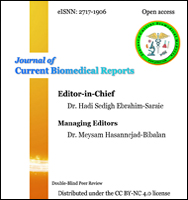Decrease of microbial contamination by application of routinely glycerol and phenol solution on human cadavers
Abstract
Human cadaver is imperative learning material for medical students. The cadavers expose to microbial contamination every time anatomists work with them. The microorganisms found in preparations’ cadavers could be pathogenic. Although the cadaver has supported a preservation method but does not inhibit microbial germination. The purposes of this study were evaluation the use of the routine solution to decrease potential contamination. Samples were collected air dissection hall and cadavers' sections after drying the cadavers, and after use of routinely glycerin and phenol solution (1.5 g phenol in 100 cc glycerol), inoculated on eosin methylene blue agar (EMB), blood agar (BA), Sabouraud dextrose agar (SDA), and SDA with the addition of chloramphenicol (50 mg/l in ethanol solution) (SC), in a Petri dish and incubated at 25 °C and 37 °C. After 3-5 days, the morphology was studied macroscopically and microscopically. We found Sporothrix schenckii; Streptomyces, Bacillus subtilis and Aspergillus flavus, Geotrichum candidum, on the samples of dryness cadavers and air dissection hall, respectively. But fungus and bacteria contamination was decreased after the use of glycerin and phenol solution. Based on the results of this study, it is suggested that glycerol and phenol solution can be used at least once a week to reduce microbial contamination and prevent the spread of the disease from the cadavers to students and professors.
Keywords
References
Yaragalla S, Rajput A. Identification of Fungal Growth from the Internal Organs of Preserved Human Cadavers. Am J Microbiol Res. 2017; 5(1):25-7.
Sri-Indrasutdhi V, Ueapattanakit J, Sommatas A. Investigation of airborne fungi and their ability to grow on formalin-fixed human cadavers. Mycosphere. 2015; 6(06):729-36.
Mobarak HJ. Experimental Study on the Effect of Air-Drying on Durability of Embalmed Human Cadavers. Iraqi J Med Sci. 2015; 13(2):178-82.
Diba K, Rahbar M, Farjah G. Microbial contamination of cadavers in the Urimia, Faculty of Medicine department of Anatomy. Iran J Basic Med Sci. 2001; 4(2):84-8.
Friedlander SF, Pickering B, Cunningham BB, Gibbs NF, Eichenfield LF. Use of the cotton swab method in diagnosing Tinea capitis. Pediatrics. 1999; 104(2 Pt 1):276-9.
Reynolds SJ, Streifel AJ, McJilton CE. Elevated airborne concentrations of fungi in residential and office environments. Am Ind Hyg Assoc J. 1990; 51(11):601-4.
Kassamali H, Anaissie E, Ro J, Rolston K, Kantarjian H, Fainstein V, et al. Disseminated Geotrichum candidum infection. J Clin Microbiol. 1987; 25(9):1782-3.
Marcellino N, Beuvier E, Grappin R, Guéguen M, Benson DR. Diversity of Geotrichum candidum strains isolated from traditional cheesemaking fabrications in France. Appl Environ Microbiol. 2001; 67(10):4752-9.
Orofino-Costa R, Macedo PM, Rodrigues AM, Bernardes-Engemann AR. Sporotrichosis: an update on epidemiology, etiopathogenesis, laboratory and clinical therapeutics. An Bras Dermatol. 2017; 92(5):606-20.
Cordovez V, Carrion VJ, Etalo DW, Mumm R, Zhu H, van Wezel GP, et al. Diversity and functions of volatile organic compounds produced by Streptomyces from a disease-suppressive soil. Front Microbiol. 2015; 6:1081.
Chen AJ, Hubka V, Frisvad JC, Visagie CM, Houbraken J, Meijer M, et al. Polyphasic taxonomy of Aspergillus section Aspergillus (formerly Eurotium), and its occurrence in indoor environments and food. Stud Mycol. 2017; 88:37-135.
Viskasari PK, Lucky P, Haryanto A. The use of lower formalin-containing embalming solution for anatomy cadaver preparation. Med J Indones. 2012; 21(4):203-7.
Verbeken G, Verween G, De Vos D, Pascual B, De Corte P, Richters C, et al. Glycerol treatment as recovery procedure for cryopreserved human skin allografts positive for bacteria and fungi. Cell Tissue Bank. 2012; 13(1):1-7.
Stevenson A, Hamill PG, Medina Á, Kminek G, Rummel JD, Dijksterhuis J, et al. Glycerol enhances fungal germination at the water-activity limit for life. Environ Microbiol. 2017; 19(3):947-67.
Xu H, Zeng X. Synthesis of diaryl-azo derivatives as potential antifungal agents. Bioorg Med Chem Lett. 2010; 20(14):4193-5.
Brenner E. Human body preservation - old and new techniques. J Anat. 2014; 224(3):316-44.
Hammer N, Löffler S, Feja C, Sandrock M, Schmidt W, Bechmann I, et al. Ethanol-glycerin fixation with thymol conservation: a potential alternative to formaldehyde and phenol embalming. Anat Sci Educ. 2012; 5(4):225-33.
Babb JR, Hall AJ, Marlin R, Ayliffe GA. Bacteriological sampling of postmortem rooms. J Clin Pathol. 1989; 42(7):682-8.
DOI: https://doi.org/10.52547/JCBioR.2.2.74
Refbacks
- There are currently no refbacks.
Copyright (c) 2021 © The Author(s)

This work is licensed under a Creative Commons Attribution-NonCommercial 4.0 International License.













